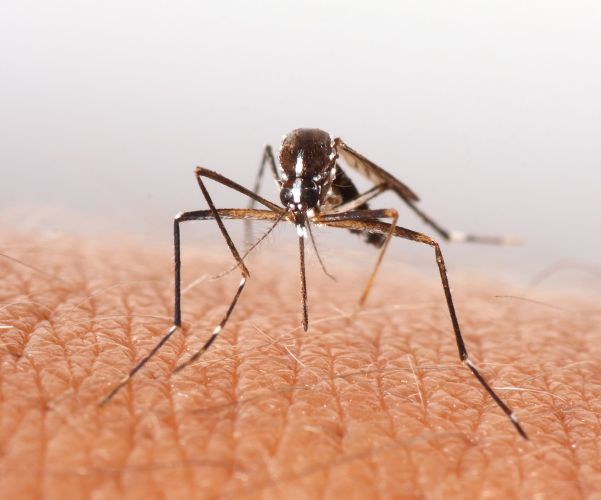Mosquitoes
Mosquitoes have long been considered summertime pests. You know that mosquitoes are annoying with their high-pitched buzzing on hot summer nights, and that their bites lead to itchy skin. Did you know that these insects pose health risks to animals and people? Mosquitoes are actually a major risk to human and animal health. Mosquito borne diseases are spread through their bites, which can cause sickness and death in both humans and animals.
Mosquito Bites
Bites from mosquitoes cause itchy skin and welts in most humans, resulting from the immune system releasing histamine when the mosquito breaks the skin. Though mosquitoes consume nectar for energy to fly, females need a blood meal to nourish developing eggs. These female mosquitoes are attracted by carbon dioxide, so humans and animals are perfect targets. Mosquitoes are also likely to fly in groups, so a person can receive multiple bites in a short time.
The Risks Mosquitoes Carry
These pests carry numerous risks for humans and animals during their active times. They are typically not active when temperatures drop below 50 degrees.
Mosquito Risk to Human Health
Mosquitoes are a risk to human health in the United States, particularly during the summer months. The Centers for Disease Control and Prevention (CDC) reports that there are about 3,000 deaths in the United States each year from mosquito-borne diseases, including:
- Zika virus
- West Nile virus
- Eastern equine encephalitis


Mosquito Risk to Animal Health
With their fur, you might think that animals would be protected from mosquito bites. However, they are at risk of health problems from mosquito bites too. Mosquitoes transmit heartworm disease, which can be fatal to dogs, cats and horses.
You can protect your animals in a few ways:
- Use a heartworm preventative that kills mosquitoes. The heartworm preventative you use also kills other blood-feeding insects such as ticks and fleas.
- Keep your pet indoors at dawn and dusk when mosquitoes are most active.
Use insect repellents for dogs such as spot-on treatments (Frontline Shield, Advantix II) or natural sprays (Wondercide, Vet’s Best). Repellents intended for humans (especially those containing DEET) are not recommended for use on animals.
The best way to prevent these diseases is to reduce the number of mosquitoes in your landscape using Integrated Pest Management (IPM).
How Integrated Pest Management Helps
Integrated Pest Management (IPM) is a pest management strategy that combines common-sense practices and ecological concepts to reduce pest populations. These practices include:
- Pesticide application when necessary
- Prevention of pests by exclusion, sanitation, and other non-chemical means; and if pesticides are used, choosing the least toxic one for the situation at hand
- Monitoring for insect population trends so appropriate pesticides can be applied only when needed
IPM’s holistic plant health care and pest management helps create and maintain conditions ideal for a landscape’s health and minimize pests’ presence and effect.
Mosquito Management
What are the ways to treat mosquitoes in your landscape?
Insecticides
Plant health care professionals may use insecticides to treat pests in a home landscape. Insecticides are most effective against immature mosquitoes when applied to areas where water collects, such as around the foundation of a house and near fish ponds or birdbaths that hold water for long periods. For control of adult mosquitoes, we recommend treatment of mosquito resting and mating sites (such as plant material) up to 6 feet high around the boundary of a property or landscape feature such as a deck, patio, or pool. For consistent control of adult mosquitoes, treatments should be reapplied monthly through the peak season of mosquito activity.
Repellents
Repellents can be sprayed on plants as a preventive measure against mosquitoes.
Biological Controls
Some natural predators feed on mosquito larvae in water bodies, including dragonflies, damselflies, and backswimmers. Unfortunately, these predators fail to survive long enough after hatching to effectively control populations for more than one generation unless abundant food is available for them all year round. Each generation of mosquito adults generally only mates once, and males die within about 2 weeks of mating. Females can live for a month or more, may lay up to 10 batches of eggs (50 to 500 per batch), and will continue to feed on blood throughout their lives.
Barriers
You can also use barriers like mesh screens across doorways leading outside or window screens over windows that open onto balconies or porches where people spend time outdoors during evenings. The barriers can help keep pests from entering your house.
Eliminating Standing Water
Eliminating standing water is an effective method of reducing mosquito populations since water is required for mosquito eggs to hatch. This practice is referred to as source reduction. Examples include old tires, buckets, flower vases, abandoned toys, and other items that collect rainwater in shady areas of your yard. If you have a pool or pond in your yard, ensure proper maintenance to prevent algae and mosquito-friendly plants such as cattails from growing.
Contact Burkholder PHC for Treatment of Mosquitoes and Other Pests of Human Health
Mosquitoes can pose significant risks to human health. We would recommend a professional evaluation to determine if your property is infested with or at risk of infestation with these pests. Our evaluation is free, and proper treatments can restore your landscape’s health. Contact Burkholder PHC today for a free consultation.

